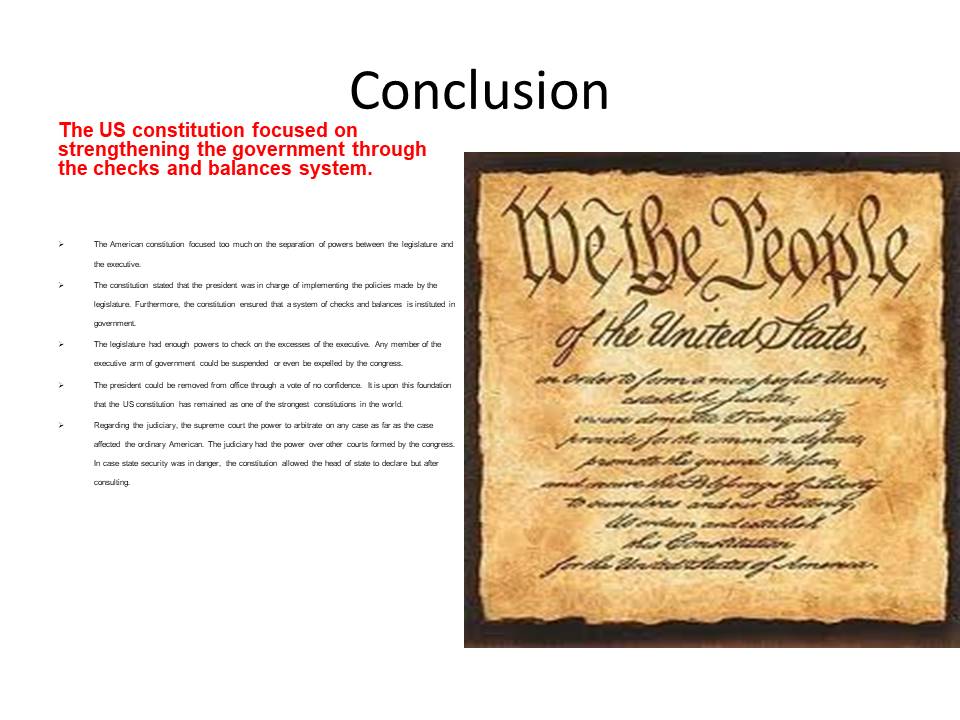- The Constitution is the supreme law of the US. It spells out the relationship between the ruled and the ruler.
Before the American constitution was established in the 16th century, a number of issues had threatened to divide the society into various segments. This would ultimately lead to disharmony and constant conflicts among societal members.
For instance, the issue of slavery was the main problem facing the drafters of the American constitution, even though the issue was treated as an economic problem. During the time, the South depended so much on agriculture implying that slavery was its economic asset. Following this realization, the North had to compromise in order to avoid any conflict that would result in war.
- The southern states never wanted to relinquish the slaves mainly because they depended on them for cheap labor.
The southern states depended heavily on exports of agricultural products. The southern investors believed that the congress could not come with a law demanding for the taxation exports. In this case, they supported the idea of taxing only imports. Moreover, the south was against the idea of abolishing slavery given that their economic activity depended on the illegal policy of slavery.
Due to this unfortunate state of affairs, the south had to come up with some suggestions, which could allow them to repossess slaves. Those slaves that had sought refuge in other urban centers, particularly in the northern states, could be returned to them. Moreover, the agreement could allow them postpone illegalization of slave trade until 1808.
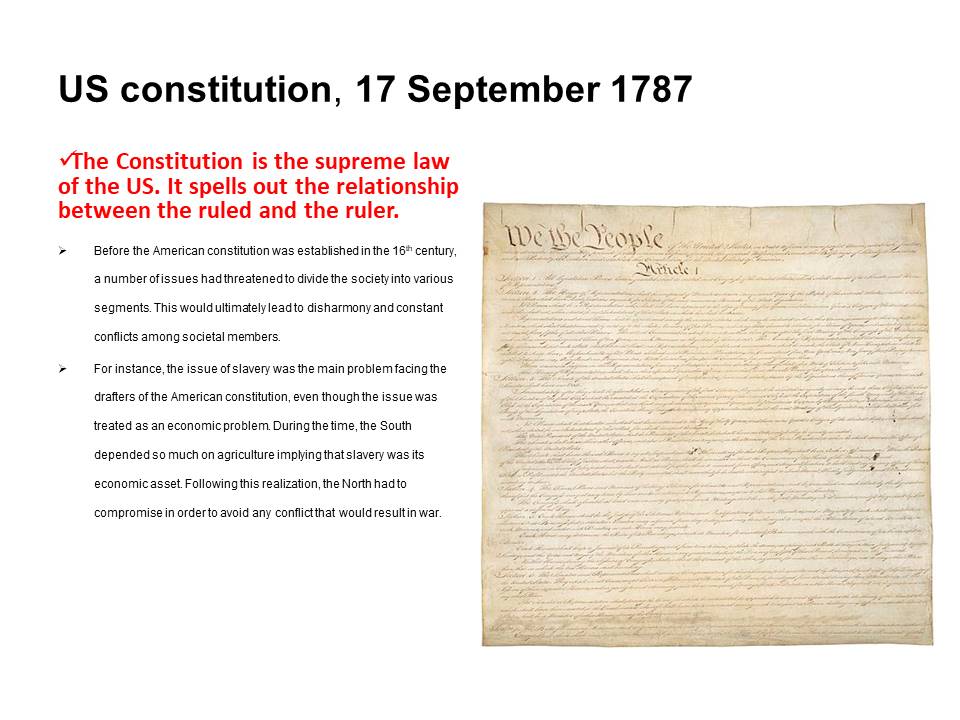
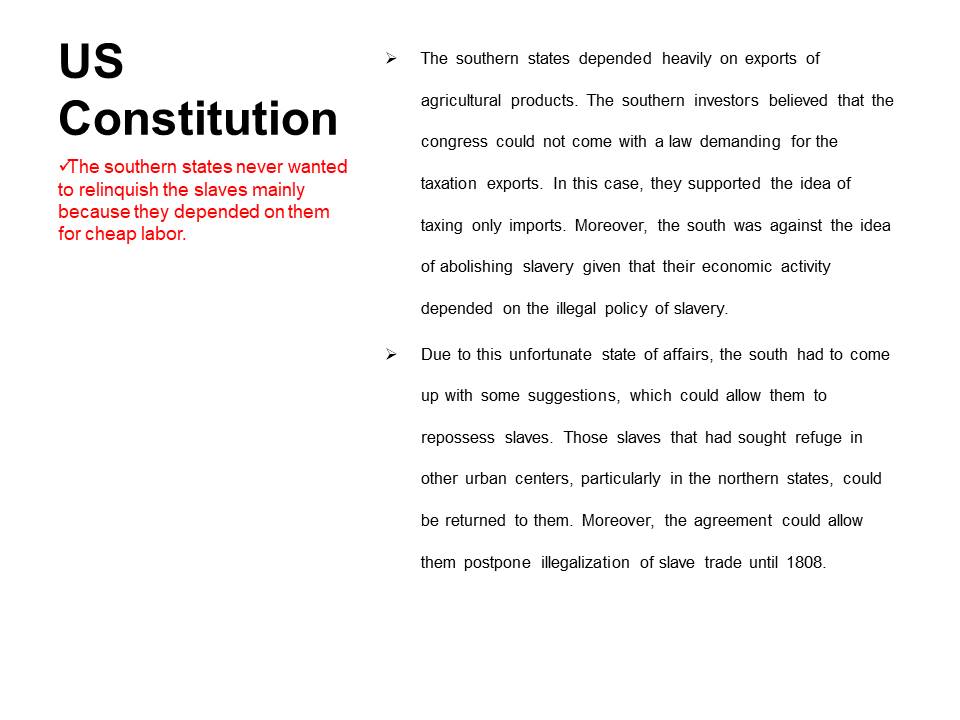
Introduction
- The constitution and constitutionalism are two concepts that are often confused. The implementation of the constitution is what scholars refer to as constitutionalism. This was the major concern of the human rights crusaders.
Approval of the constitution could see the southern states struggle for over four months without something solid to take home.
Before the states agreed on a power sharing formula among the arms of government, some proponents of the human rights demanded that the constitution incorporates the human rights in order to prevent the abuse of office.
The human rights crusaders believed that a centralized government would compromise the rights and freedoms of an individual in society.
Before the 1788 summer, one of the states appended its signature to the American constitution, making it the law of the land.
New Hampshire was the ninth state to append its signature to the new constitution. In total, the document had seven articles, each article with its own provisions under several sections. These articles will be discussed in detail.

Article I
- Article one concentrated on the powers, responsibilities and functions of the legislature.
Article I of the US constitution had ten sections. The first section dealt with issues to do with legislation powers. The constitution demanded that congress would be the ultimate authority in matters related to crafting laws. The congress would consist of two chambers including the senate and the House of Representatives. The second section explained the qualifications, election procedures, term, roles, and functions of the congress. A congressperson had to attain the age of twenty-five to be eligible to vie.
Furthermore, each state had to be treated equally meaning that resources had to be allocated based on the need not race. The two chambers of parliament had the powers to select one individual to act as the speaker for specified term.
The third section of article I addressed matters to do with the composition of the senate. The terms of service were set for senators in section three. In the fourth section, the constitution fixed the rules for vying for the seat of the senator. However, the congress had the power to make changes to some laws as far as such changes were deemed important.
The senate in progress. Senators selected the speaker who controlled the affairs of the house.
- The senate had various functions, among them approving the budget.
The two chambers of parliament were required to oversee their own elections. This was the provision of section five of the first article of the US Constitution. The sixth section looked into the social welfare of the senators, requiring the treasury to pay them gratuities after retirement. Section 7 tried to differentiate the powers of the two chambers of parliament. It was agreed that matters related to budgetary allocations would originate from the House of Representatives and could only be sanctioned by the senate.
Section 8 was clarification of the seventh section because it laid down the functions of the congress. In the eighth section, the congress was given the power to collect taxes, pay debts, and provide funds for the defense forces of the United States.
This would be done through sanctioning the budget proposed by the executive arm of government. Regarding matters to do with migration and citizen, the first article, through section 9, allowed the senate to make laws that would ensure Americans do not face unfair competition from immigrants. The last section of article one prohibited states from entering into contracts with other entities without informing the government and the senate.
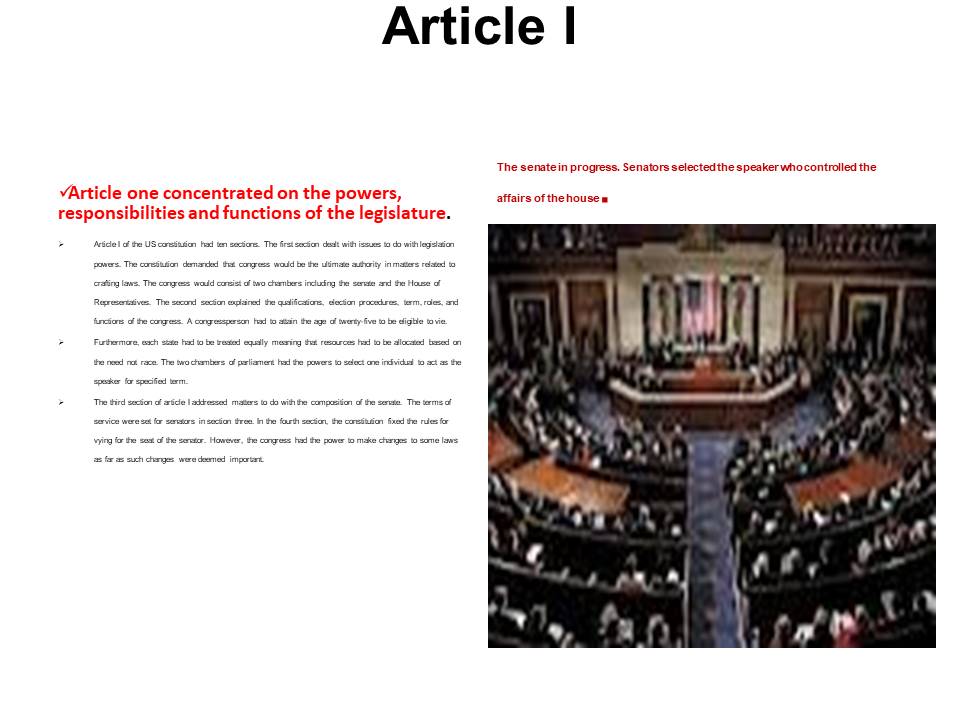
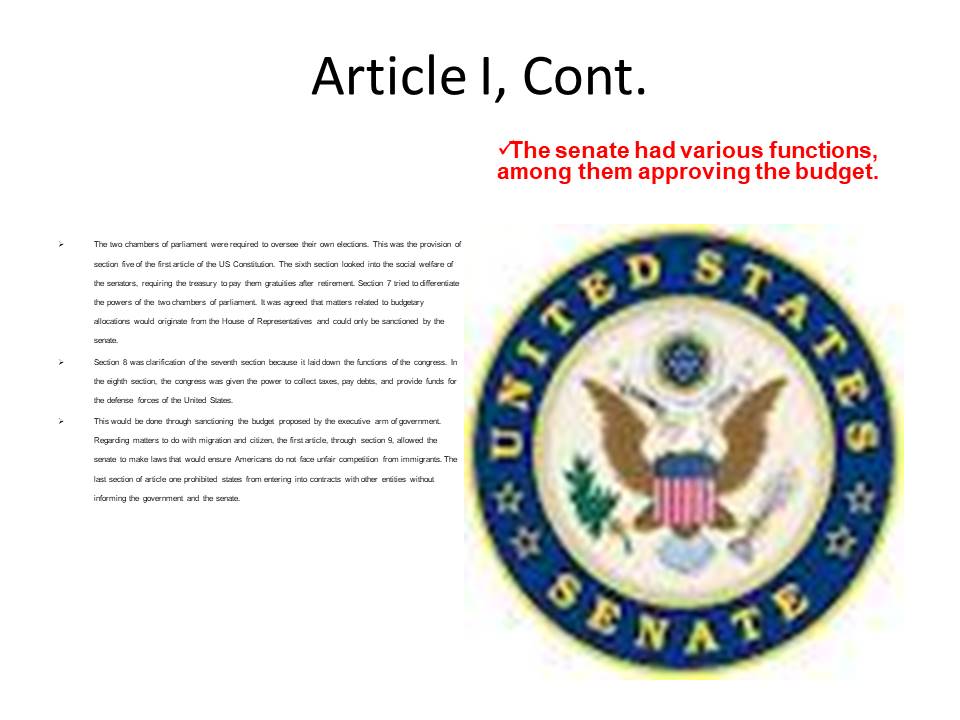
Article II
- The president was supposed to consult extensively before making any decision.
The second article of the constitution had four major sections each with different provisions. The first section discussed about the powers and the authority of the president. In other words, it talked about the executive arm of the government.
The president could hold office for a term of four years, together with his vice. The process of electing the president was made to be rigorous to ensure transparency and fairness. In this regard, the constitution declared that it would be unfair or even illegal for the state to allow the immigrants to vote.
Only Native Americans would vote, irrespective of their race, skin color, gender, or even ethnicity. In this case, the Native Americans referred to those who were born in the US and have lived in the country for a period not less than ten years prior to the presidential elections.
- The president could be the commander in chief of the armed forces.
The second section of article II explains the roles, functions, and powers of the president. The president would be the commander in chief of the armed forces, as well as the commander of various militias of various states.
In this regard, the president would demand for opinions from principal officers in various ministries. Moreover, the president had the power to pardon prisoners and declare war in cases of emergencies. The powers of the president to declare war was based on the Locke’s prerogative powers.
In section three of article II, the president had to report the progress of the government to the congress. This was because the congress was powerful, given the fact that it represented the views of the citizens. The last section of article II described ways through which the head of state, his or her deputy, as well as other senior government officials would be removed from office even before the expiry of their terms.
This would be done through impeachment meaning that the congress would organize for a vote of no confidence in case the president tried to be indifferent to the sufferings of citizens.
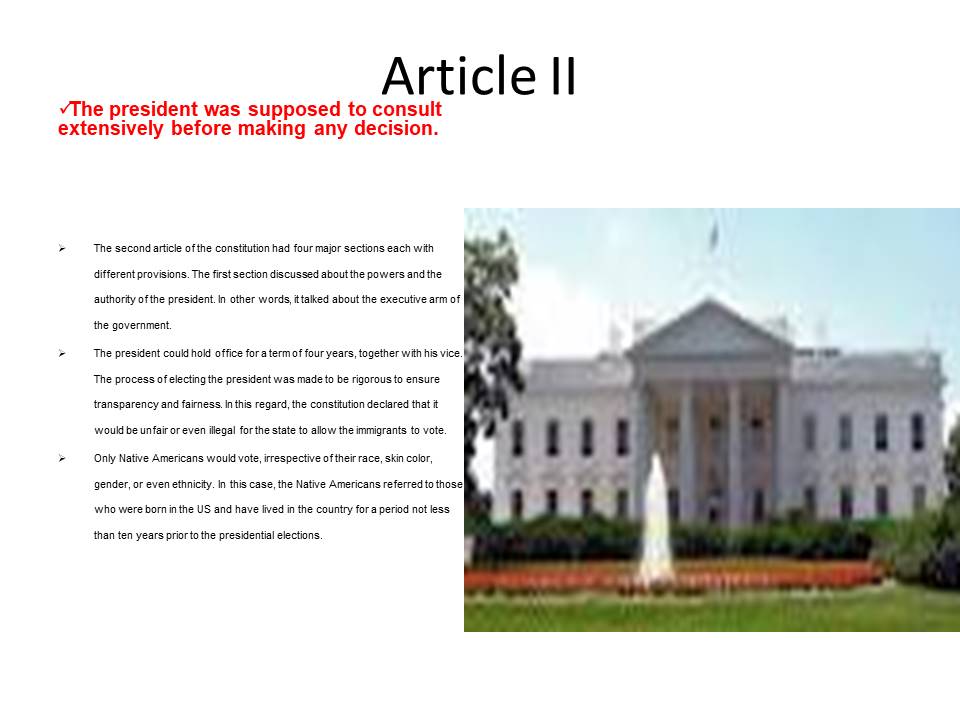
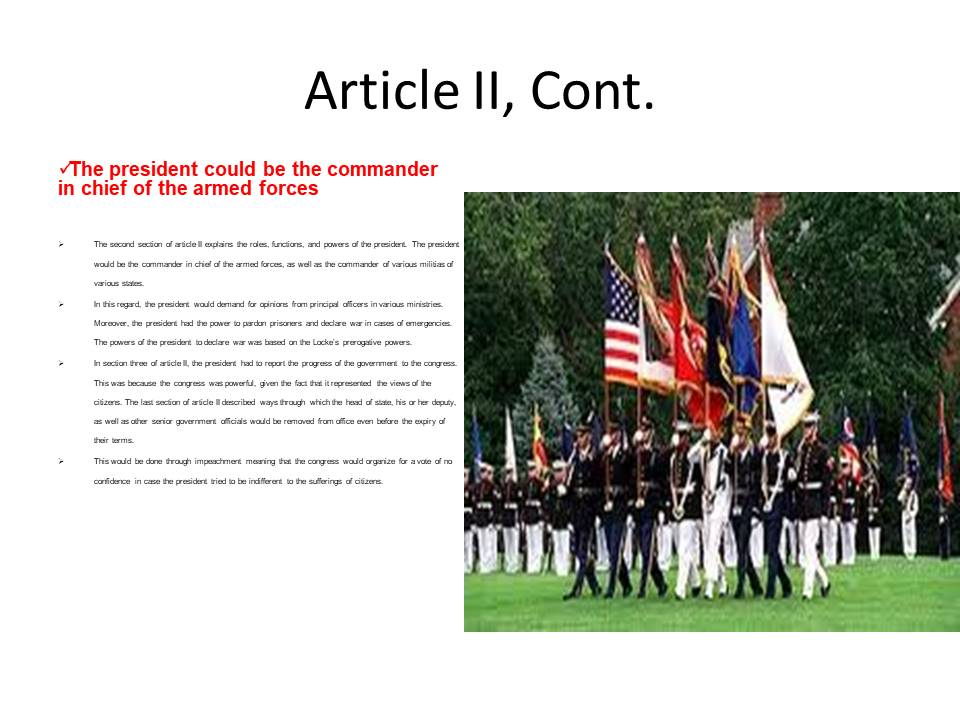
Article III
- “I do solemnly swear (or affirm) that I will faithfully execute the Office of President of the United States, and will to the best of my Ability, preserve, protect and defend the Constitution of the United States.” The above statement shows that the office of the president was the most valued hence the judiciary had to treat any matter related to it seriously.
Article 3 of the US constitution had only three sections, which comprehensively talked about the judiciary arm of government. The first section of the article clarified the top most court in the country, which was the Supreme Court.
All judicial matters affecting the American society could be resolved by the court in case other courts had failed to offer insights. Other courts could be formed by the congress but they could not have powers as those of the supreme court of the US.
The Supreme Court could turn down the decision made by the inferior courts. However, the inferior court could do nothing after the Supreme Court had issued its verdict.
The jury of the supreme and inferior courts were expected to conduct themselves in an orderly manner meaning that they had to be possible of high integrity in society.
The second section of article three talked about the powers, functions, and responsibilities of the American judicial system. The American judiciary was to be independent meaning that it could make decisions on cases without necessarily favoring any side.
The judiciary had powers to arbitrate on issues affecting the country regardless of the source.
- The supreme court judge could overturn the decision of the inferior courts, especially those formed by the congress.
The judiciary could therefore arbitrate on matters touching on the executive, legislature, and even the military.
Unlike other constitutions of other countries, the American constitution allowed the American judges to resolve cases involving two foreign states, as long as the US was a party.
The third section of article III tried to shed light on cases related to treason. The court could not charge an American citizen of treason unless solid evidence was provided.
The constitution never allowed the judiciary to charge an individual with treason but instead dedicated the duty to the congress.
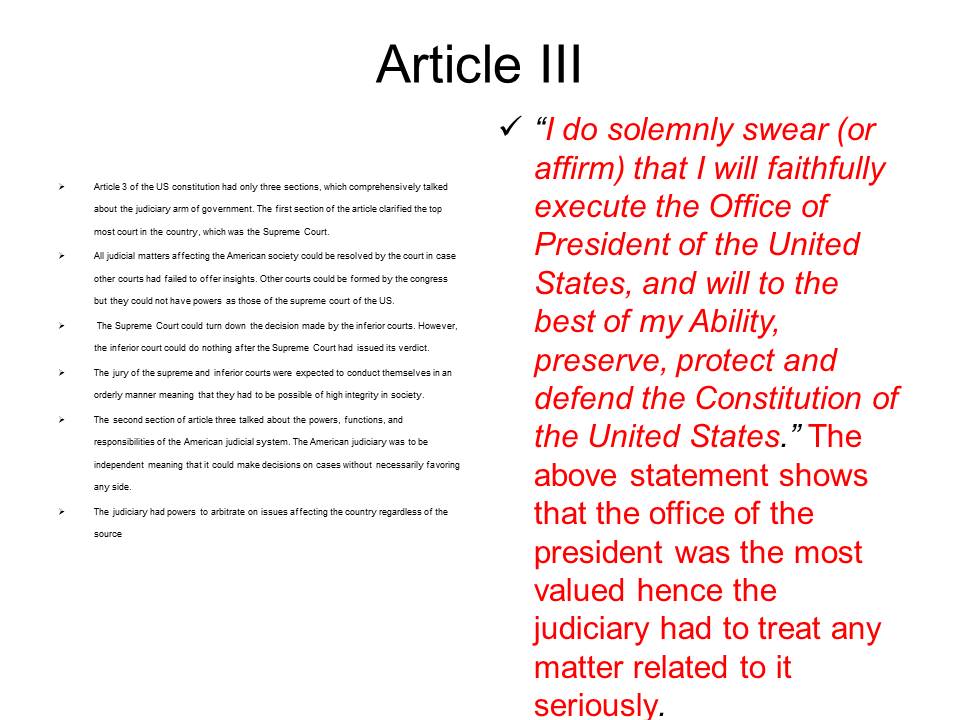
Article IV
- The states could not be split. However, the new states could be incorporated into the union.
Article IV delved into the powers, roles, responsibilities, and the administration of of the states of America.
The constitution would respect the resources of each state and would ensure that records are kept to prevent any form of fraud.
In case of conflicts between or among states, the central government and the senate would intervene to resolve the disputes without favoring any side.
The second section of article four stated that each American citizen had the power to move freely from one state to the other without necessarily carrying any form of identification.
In case an individual committed a crime in one state and escaped to another state, the recipient state had the responsibility to arrest the criminal and present him or her to the respective state for trial.
- The central government could have jurisdiction over all states, especially in matters related to security
In case an individual flees one state because he or she has been ordered to undertake a community service, such an individual would be forced to engage in community service in his or her new state.
The third section clarified that no new state would be formed apart from those existing at the time when the new constitution was promulgated.
However, the law allowed the government to encourage the existing states to join the union but not to split from the existing ones.
The congress had the power to come up with rules and regulations that would govern particular states in case some rules were violated.
The constitution would guarantee each state freedom. This was the provision of section four of article IV. The central government had to provide protection to all states.
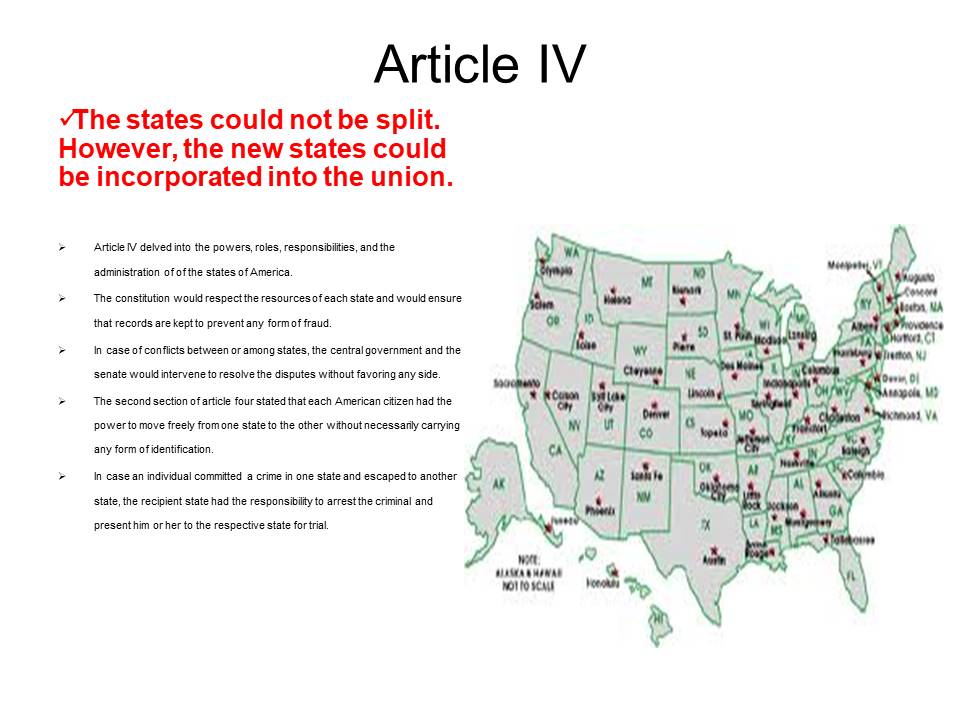
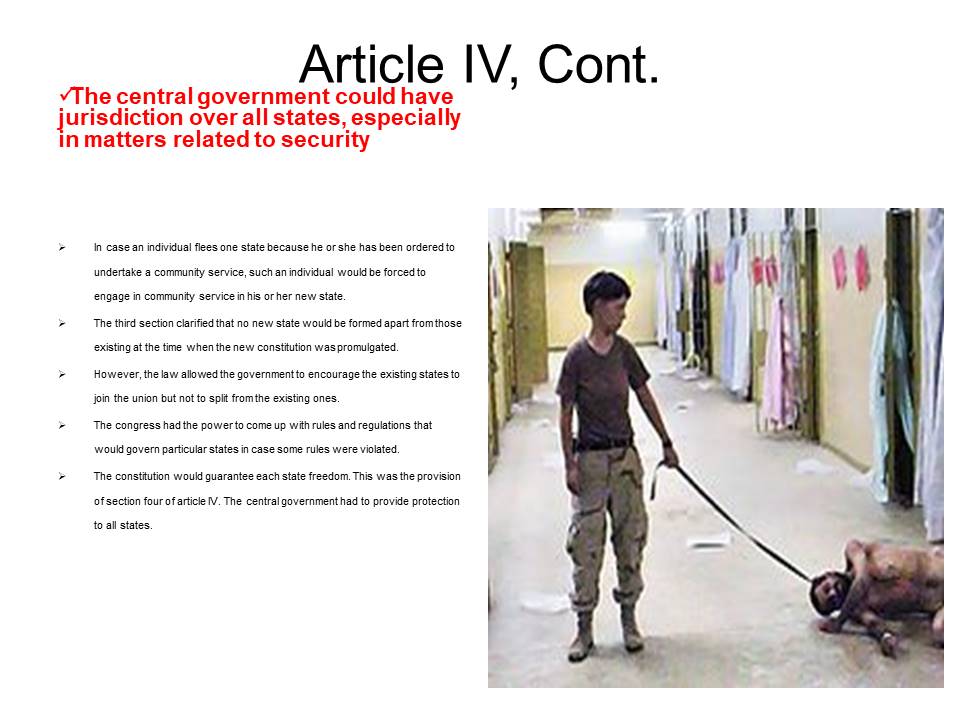
Article V
- “Ratification may be proposed by the Congress; Provided that no Amendment which may be made prior to the Year One thousand eight hundred and eight shall in any Manner affect the first and fourth Clauses in the Ninth Section of the first Article; and that no State, without its Consent, shall be deprived of its equal Suffrage in the Senate”. This clause shows that the congress could come up with some changes.
Article V was very brief. In fact, it was the shortest article. The article addressed the issue of amending the constitution.
The process of amending the constitution was complex meaning that it could not be tampered with by the selfish politicians who would try to amend the constitution to achieve their selfish interests. However, the constitution could be amended but through the legislature.
The legislature could amend it through a two third majority vote. The amendments to the constitution could only be allowed after the first year. Amending the constitution under the current system of government in the US is one of the difficult things.
For the amendments to be allowed, each state could be given a chance to vote. Each state could be represented in the senate meaning that discrimination was highly discouraged.
The process of amending the US constitution is very complex, which has allowed it to survive for a long time. In the modern society, no constitution can be compared with that of the US simply because it cannot be amended by an individual.
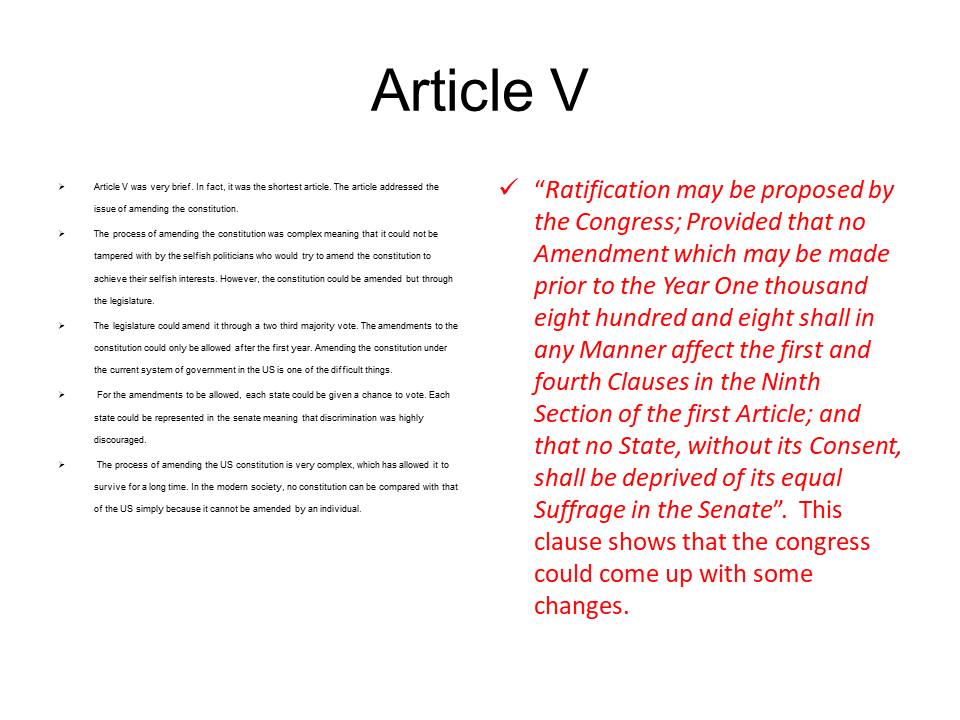
Article VI
- Civil servants at work. They thought their services could be terminated prematurely.
Article V. of the American constitution was very brief. It did not have any section since the writers of the constitution wanted to suppress fears that the constitution would lead to social, economic or political disputes.
All the contracts between the United States and private organizations would be perceived to be valid. Furthermore, the government would honor its deals and pay its debtors.
Those serving the government in various positions could not lose their jobs given the fact that some positions would cease to exist.
Consequently, the article assured office holders that they would retain their positions until the new government was sworn in. Civil servants had been misinformed that they would lose their jobs should the new constitution come into effect.
Furthermore, the office holders had the right to defend their positions legally under the new constitution.
This was to assure judges, legislators and senior servants that they had a chance to present their candidature for selection or election, as long as they qualified.
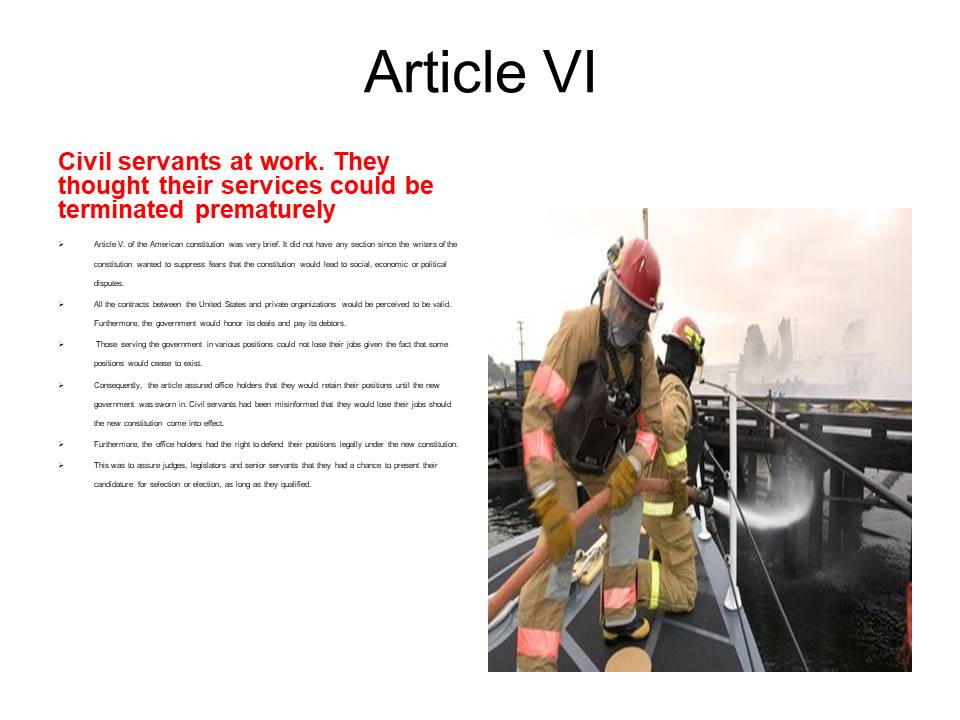
Article VII
- The ratification of the constitution was witnessed by a number of senators. Some appended their signatures.
Article VII discussed about the procedures of ratifying the constitution. The constitution had to be ratified by at least nine states.
The article gave the names of those who witnessed the promulgation of the constitution. Some of the witnesses appended their signatures meaning that they were in agreement with the provisions of the constitution.
Some of those who appended their signatures include the following.
- G°. Washington: Presidt and deputy from Virginia.
- Delaware, Geo: Read: Gunning Bedford jun, John Dickinson, Richard Bassett.
- Jaco: Broom, Maryland: James McHenry.
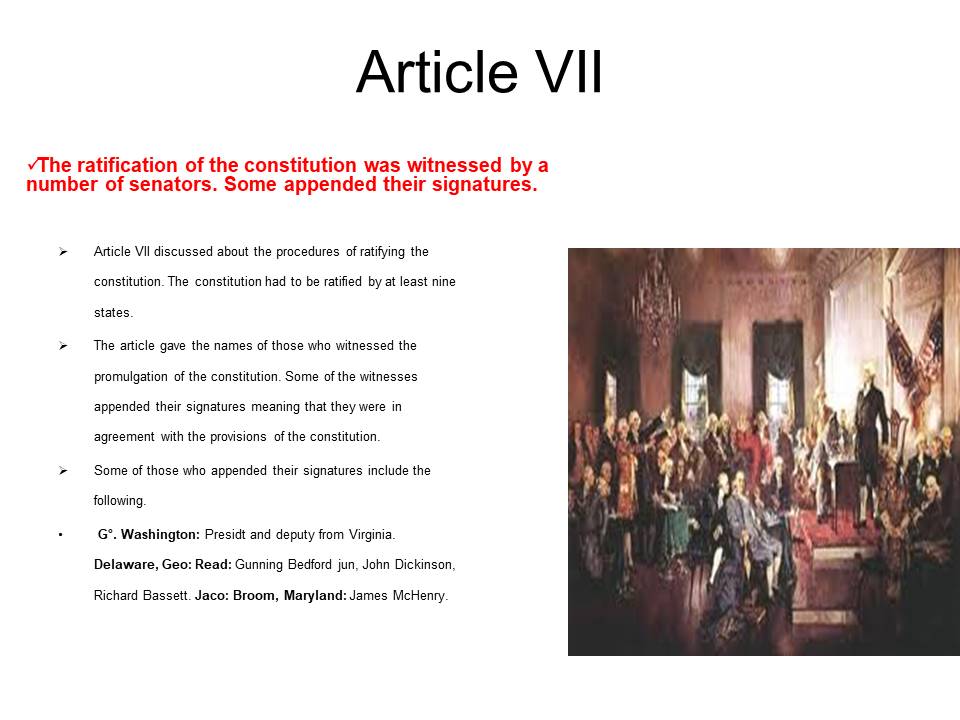
Conclusion
- The US constitution focused on strengthening the government through the checks and balances system.
The American constitution focused too much on the separation of powers between the legislature and the executive.
The constitution stated that the president was in charge of implementing the policies made by the legislature. Furthermore, the constitution ensured that a system of checks and balances is instituted in government.
The legislature had enough powers to check on the excesses of the executive. Any member of the executive arm of government could be suspended or even be expelled by the congress.
The president could be removed from office through a vote of no confidence. It is upon this foundation that the US constitution has remained as one of the strongest constitutions in the world.
Regarding the judiciary, the supreme court the power to arbitrate on any case as far as the case affected the ordinary American. The judiciary had the power over other courts formed by the congress. In case state security was in danger, the constitution allowed the head of state to declare but after consulting.
